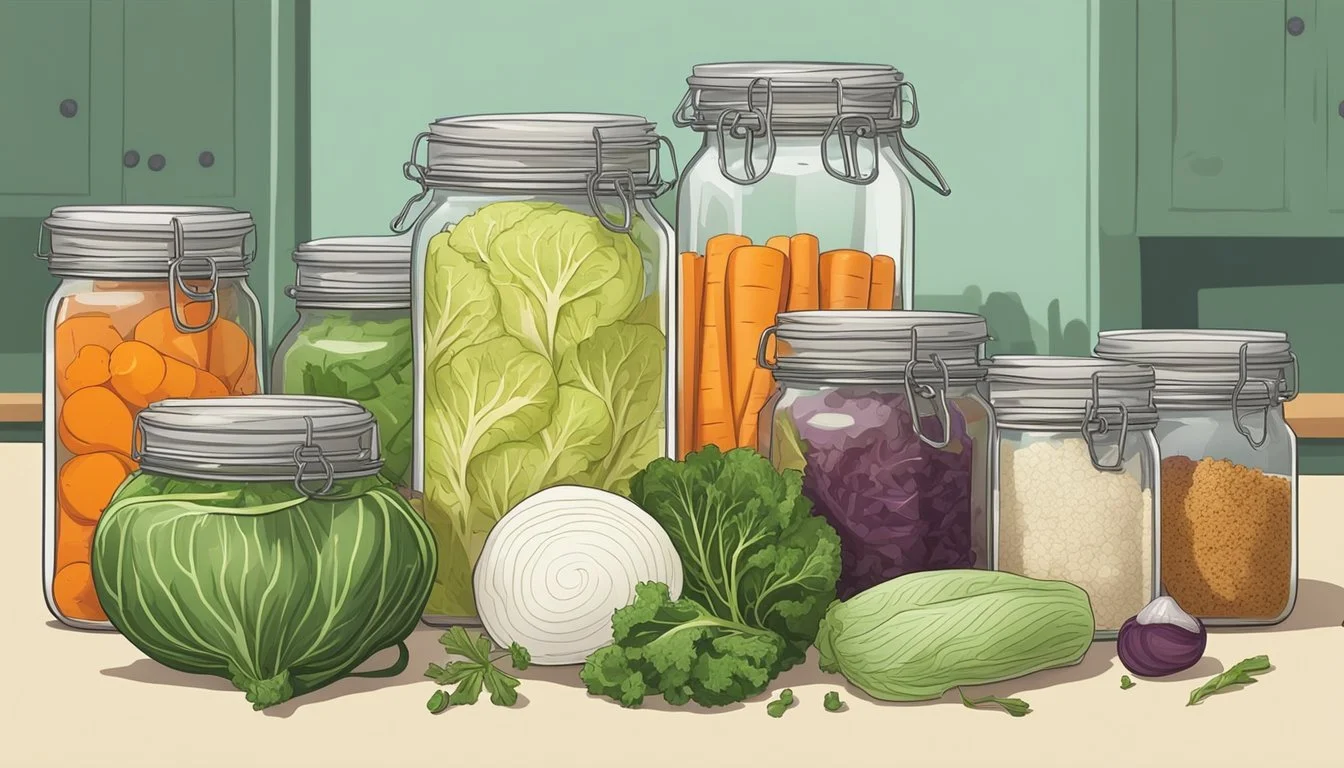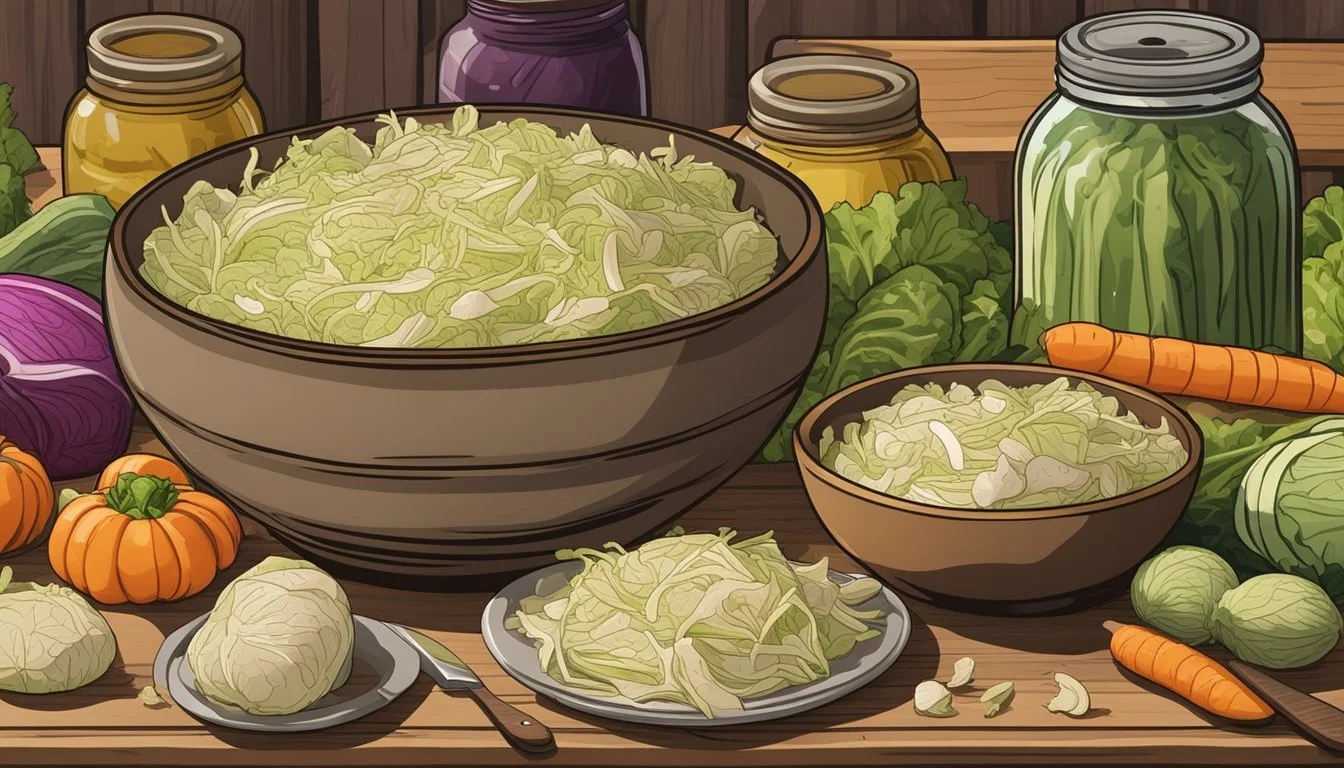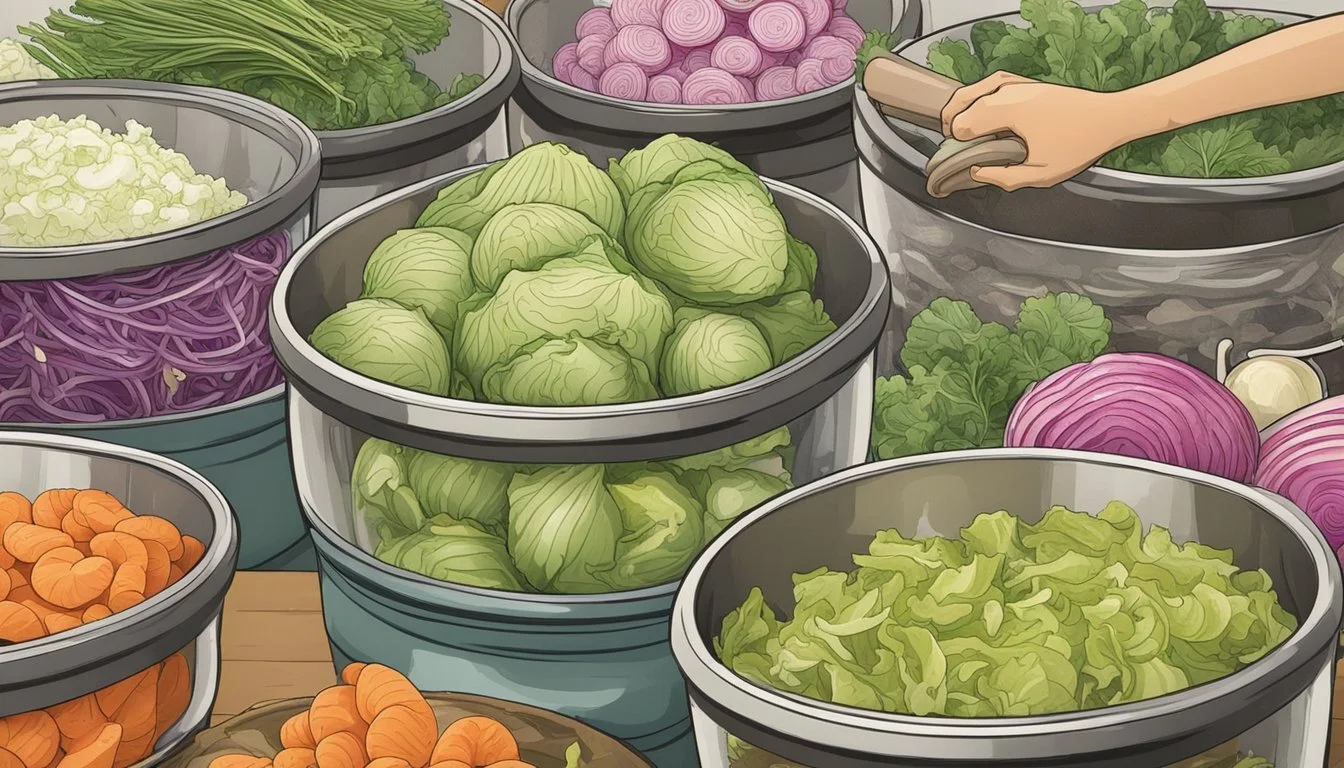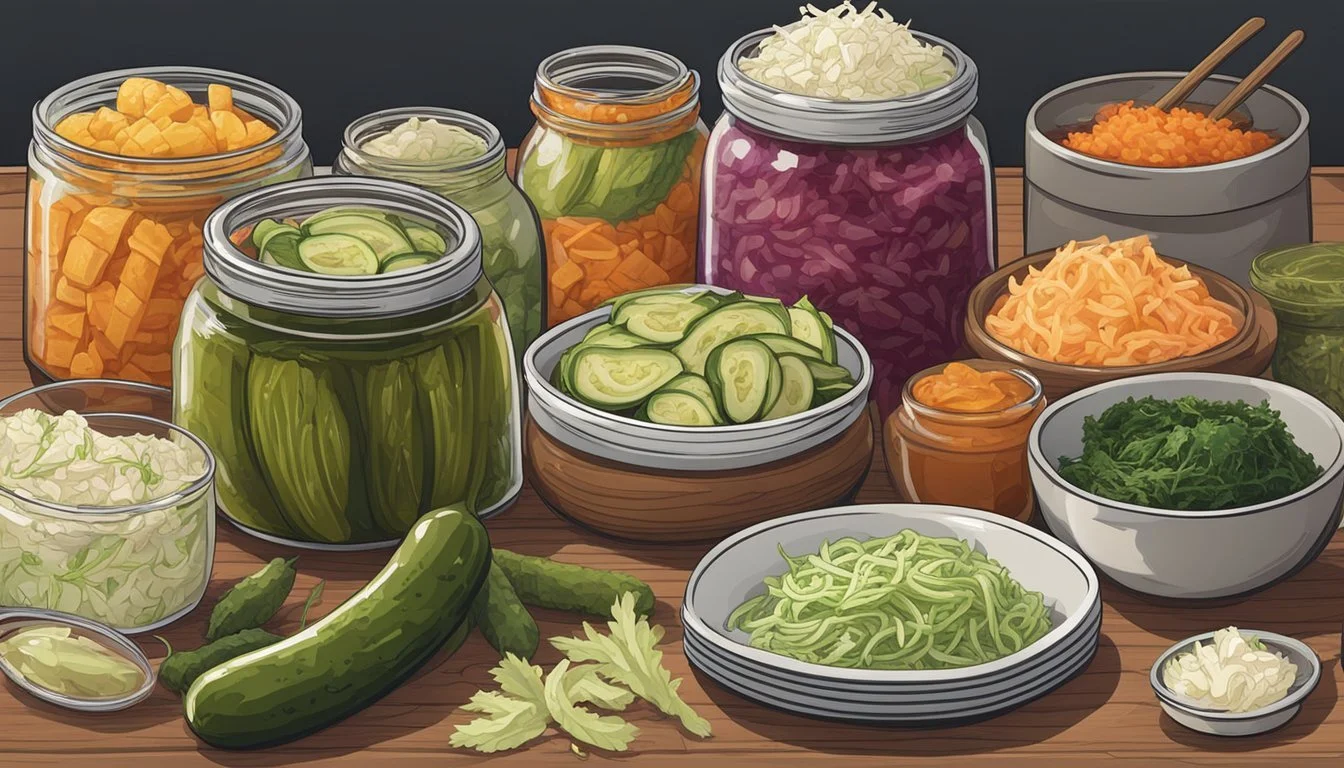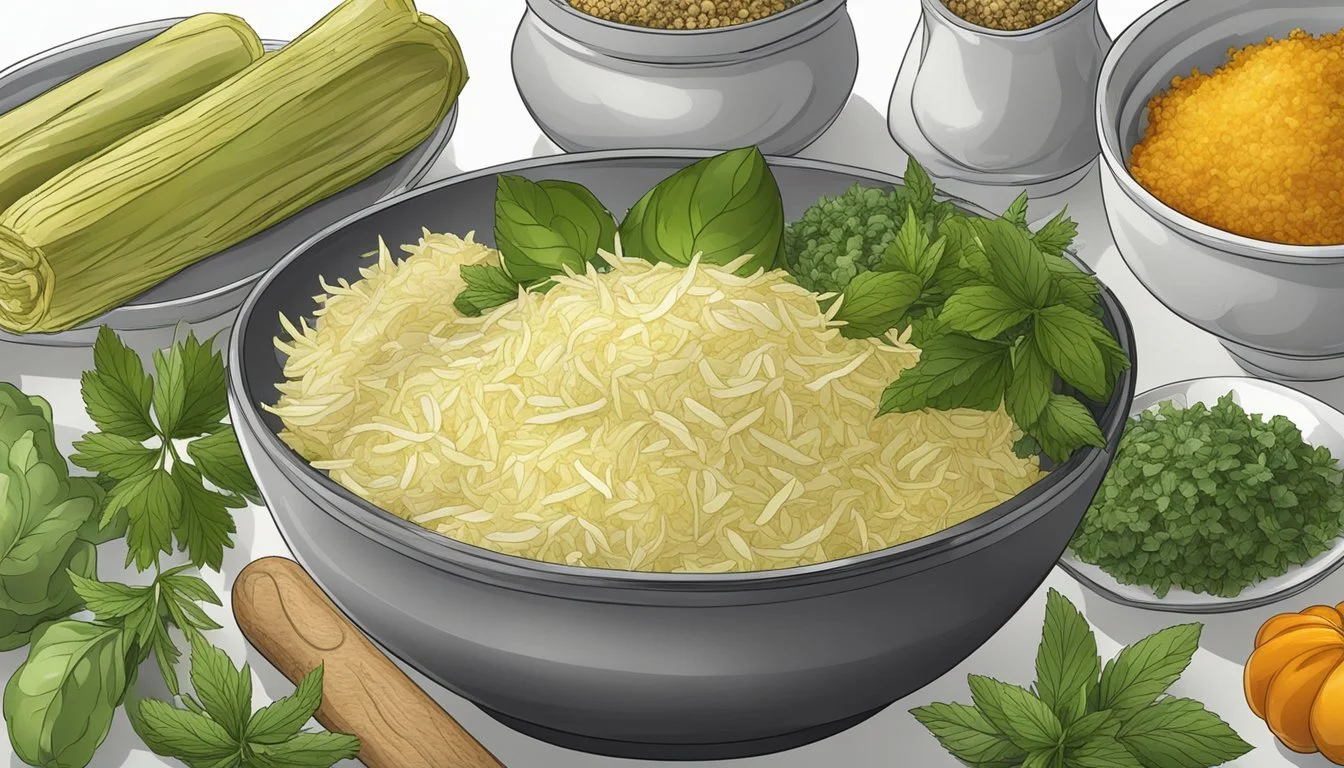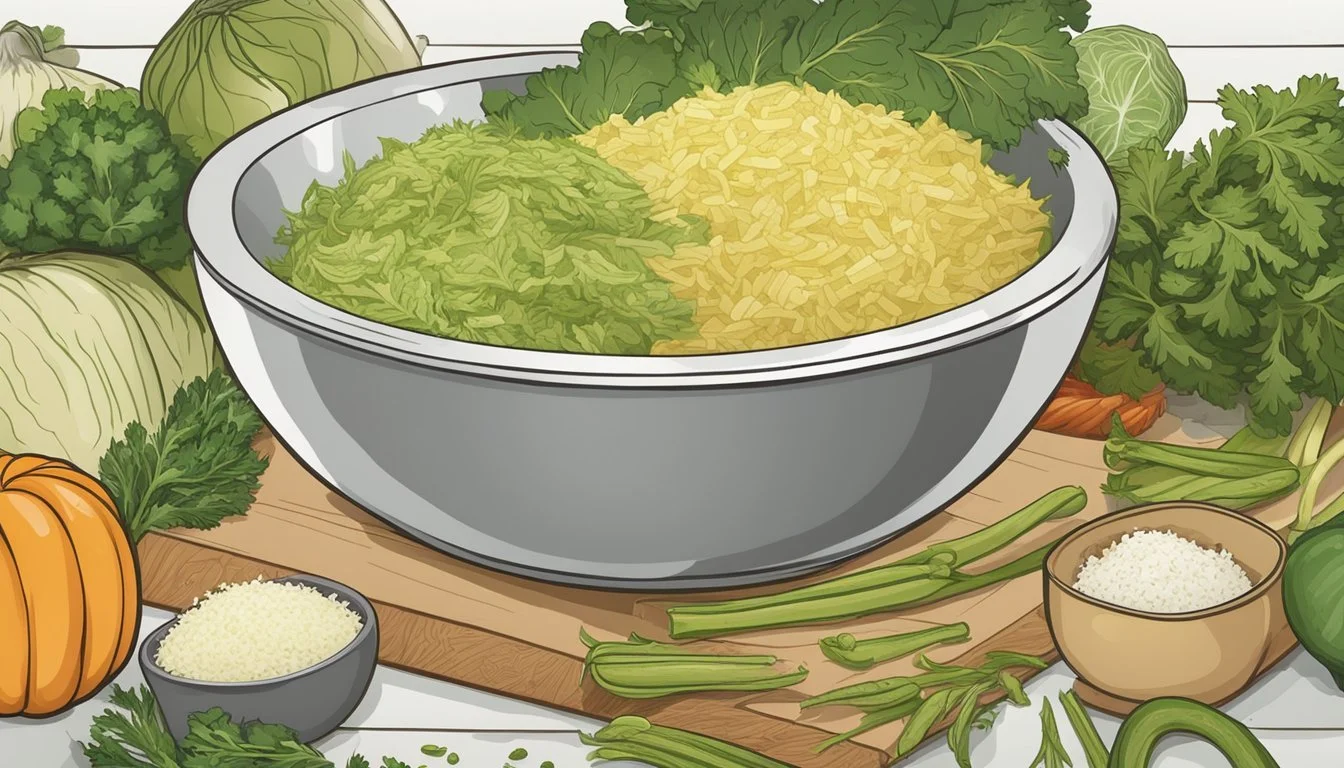Sauerkraut Substitutes
Top Alternatives for Your Dishes
Sauerkraut, a fermented cabbage dish, has long been a traditional staple in many cultures, particularly across Central Europe. Esteemed for its tangy flavor and digestive benefits, this condiment is typically composed of finely sliced cabbage and salt that undergo natural lactic acid fermentation. The result is a sour, complex taste that complements dishes like sausages and pork, and adds a refreshing contrast in heavier meals. Rich in vitamins and probiotics, sauerkraut is not just a side dish but a healthful addition to any diet.
However, not everyone has a taste for sauerkraut, or it may not always be readily available. In such cases, a variety of substitutes can offer similar flavors or serve comparable roles in recipes. Options range from other fermented vegetables like kimchi, which brings a spicy twist to the cool crispness of sauerkraut, to non-fermented alternatives such as coleslaw, which mimics the texture without the sourness. For those looking to replicate the acidity of sauerkraut juice, vinegar can serve as a quick and easy replacement.
Determining the best substitute for sauerkraut hinges on the specific needs of the recipe and the flavor profile desired. By understanding the key characteristics of sauerkraut, one can select an alternative that maintains the integrity of the dish while catering to individual preferences or addressing availability issues. Whether the goal is to mimic the traditional method of fermentation or provide a companion to robust foods, there's a potential stand-in that can rise to the occasion.
Understanding Sauerkraut
Sauerkraut is a traditional fermented food known for its sour taste and health-promoting properties derived from the fermentation process.
History and Origin
Sauerkraut originated in Central Europe as a means of preserving cabbage. Fermentation has been a part of German cuisine for centuries, though the concept likely spread from China. The method of lactic acid fermentation was found to not only preserve the vegetables but also to add a unique flavor.
Health Benefits
Sauerkraut is rich in probiotics, particularly lactobacillus bacteria, which promote healthy digestion. It is a source of vitamins C and K, as well as minerals like potassium and magnesium. The fermentation process enhances its nutritional value, making it beneficial for the immune system.
Culinary Uses
Sauerkraut is traditionally paired with pork in German cuisine. It garnishes the iconic Reuben sandwich and complements various dishes, providing a tangy flavor. It's not just a side; it's also used as a condiment to add zest to a meal.
Sauerkraut Substitutes Overview
Sauerkraut substitutes can be critical for those who either cannot find it or seek alternatives due to dietary restrictions, flavor preferences, or cooking needs. This section explores various considerations and categories for these substitutes.
Factors to Consider
Flavor: Sauerkraut is known for its distinct sour taste, which comes from the fermentation of cabbage. Substitutes should aim to offer a similar level of sourness without overpowering the rest of the dish.
Texture: The crunchy texture of sauerkraut can contribute significantly to a dish. Substitutes may vary in texture, but should attempt to mimic this crunchiness.
Fermentation: Part of sauerkraut's unique profile comes from being fermented. While not all substitutes are fermented, those that are can provide comparable probiotic benefits.
Ingredient Compatibility: Substitutes should blend well with other ingredients in a recipe and not alter the intended outcome drastically.
Substitute Categories
Fermented Substitutes:
Kimchi: A Korean variant that offers a similar texture and benefit from fermentation but is typically spicier.
Pickled vegetables: Options such as dill pickles maintain the acidic flavor and crunch, though they lack the fermented aspect.
Unfermented Substitutes:
Coleslaw: A non-fermented cabbage dish that can sometimes stand in, particularly in terms of crunch and when extra sourness is added.
Vinegar-based substitutes: White wine vinegar or other vinegars are sometimes used to mimic the sourness of sauerkraut juice.
In summary, when a recipe calls for sauerkraut, cooks have a spectrum of substitutes they can consider based on how closely they wish to match the original ingredient's flavor, texture, and fermented quality.
Vegetable-Based Substitutes
When looking for alternatives to sauerkraut, several vegetable-based options offer similar flavors or textures.
Kimchi
Kimchi, a Korean staple, is a flavorful substitute, typically made from fermented napa cabbage and carrots, along with seasonings like onion, garlic, and chili peppers. The fermentation process gives kimchi its characteristic taste, which can be used in equal amounts as sauerkraut in recipes.
Pickled Cabbage
Pickled cabbage shares the tangy flavor profile with sauerkraut but without the fermentation. Quick-pickled cabbage, often made with apple cider vinegar, provides a crunchy and savory option that can readily complement dishes traditionally served with sauerkraut.
Coleslaw
Coleslaw, a mix of shredded cabbage, carrots, and onions with a creamy or vinaigrette base, can serve as a fresh, non-fermented alternative. Its ingredients allow coleslaw to add both texture and a mild taste to meals, akin to sauerkraut but with a unique, tangy twist.
Shredded Cabbage
Simply shredded fresh cabbage can be seasoned with apple cider vinegar, salt, and other spices to mimic the flavor of sauerkraut. Although missing the fermented aspect, it offers a comparable texture and can be a quick, homemade substitution in many dishes.
Vinegar and Acidic Substitutes
When seeking to replace sauerkraut in a dish, one may opt for vinegar and acidic substitutes to mimic the tangy and sour profile that sauerkraut offers. These substitutes can be adjusted for the desired sourness and can also add a unique flavor twist to recipes.
Different Vinegars
Using vinegar can provide the acidity that mimics sauerkraut's tang. Here's a breakdown of vinegar options:
White Vinegar: A clear option that offers a clean, strong sourness. It is versatile and can be used in a pinch for most recipes.
Apple Cider Vinegar: This vinegar has a milder taste with a subtle apple flavor; it pairs well with dishes that benefit from a fruitier undertone.
White Wine Vinegar: For a more refined taste, white wine vinegar offers a milder acidity and is excellent for dressings or marinades.
Sherry Vinegar: With a complex and slightly sweet taste, sherry vinegar is suitable for recipes that can handle a deeper flavor profile.
One can substitute sauerkraut with a mixture of vinegar, salt, and a pinch of sugar to balance out the flavor. The amount of vinegar used should align with the recipe's required sauerkraut volume, and seasonings can be adjusted to taste.
Citrus Juices
Citrus juices are ideal for fresh, uncooked applications or when a burst of citrus flavor is welcome. The most commonly used citrus for such substitutions includes:
Lemon Juice: With its high acidity and recognizable zest, lemon juice can come in handy, especially in salads and slaws.
Lime Juice: Similar to lemon, but with a distinct flavor, lime juice is suitable in dishes that call for a more tropical or vibrant tasting note.
In both cases, the citrus juice can be combined with a pinch of salt to better imitate the flavor profile of sauerkraut. The zesty sourness from these juices will enhance the food without overpowering it, as long as it's used in the right proportions.
Condiments as Substitutes
Condiments can offer a zest and tang that closely mimics sauerkraut's distinctive flavor. These alternatives are particularly useful for those who seek a similar tangy taste without fermentation.
Relishes
Relishes, with their pickled origins, serve as a crunchy, tangy substitute for sauerkraut. Dill pickles, chopped finely, can become a flavorful dill relish that brings a similar zesty note to dishes. A mixture of chopped pickles, vinegar, and onion often characterizes this condiment, making it a suitable sauerkraut stand-in for hot dogs and sandwiches (What wine goes well with sandwiches?).
Mustards
Mustard brings a sharp and tangy profile that can replace sauerkraut's bite in recipes. Yellow mustard is particularly useful due to its mildness and accessibility. It can be used as a topping to enhance dishes like sausages and meats with its vinegary undertones and subtle spice from pepper.
Salsa Verde
Salsa verde, a vibrant green sauce made from tomatillos and green chili peppers, offers a fresh, herby alternative to sauerkraut. While more Mexican in flavor, its acidity and peppery tone can replicate the kick sauerkraut gives to dishes. As a condiment, it works well with grilled foods and tacos, adding a clean, sharp taste.
Herb and Spice Alternatives
When seeking substitutions for sauerkraut, one can find viable alternatives within the realm of herbs and spices. These seasonings can impart the complex flavors associated with fermented cabbage, though they lack the fermentation aspect.
Dill Seeds and Other Herbs
Dill Seeds: Mimic sauerkraut's unique taste by incorporating dill seeds into recipes. They offer a tangy, slightly earthy flavor that can complement dishes typically served with sauerkraut.
Herbs: Various herbs like parsley or tarragon may be added for their aromatic qualities. These do not replicate sauerkraut's acidity but can introduce a fresh, herby dimension to dishes.
Caraway Seeds and Spices
Caraway Seeds: They are often used in sauerkraut and can act as a direct spice substitute. Caraway imparts a warm, anise-like flavor which can add complexity to a dish.
Spices and Seasonings: Alternatives like black pepper or fennel seeds can be used to generate a profile similar to sauerkraut's. Use fennel seeds for a licorice-flavored twist or black pepper for a more universal seasoning. Spices such as a pinch of chili peppers can add a subtle kick, replacing sauerkraut's sometimes spicy character.
Cooking Techniques for Substitutions
When replacing sauerkraut in recipes, one can utilize techniques such as pickling or sautéing to achieve similar flavor and texture profiles. The following subsections delve into specific methods to prepare substitutions such as fast-pickled cabbage and sautéed cabbage.
Pickling at Home
Homemade pickled vegetables can be a fantastic substitute for sauerkraut; however, one must pay attention to the pickling process to ensure the desirable balance of flavors. Fast-pickled cabbage is a quick alternative that involves the following steps:
Mix a brining solution of water, vinegar, salt, and sugar. The typical ratio for a basic brine is 1 cup of water to 1 tablespoon each of salt and sugar, adjusted to personal taste.
Slice the cabbage thinly and place it in a sterile jar.
Pour the brine over the cabbage, ensuring it is fully submerged. Optionally, add flavors like garlic or dill for extra zest.
Seal the jar and let it sit at room temperature for a few hours before moving it to the refrigerator.
This method introduces a sourness and crunch reminiscent of sauerkraut without the lengthy fermentation process of homemade sauerkraut.
Sautéing Cabbage
Sautéed cabbage serves as a warm and tender alternative to sauerkraut. The key is to cook the cabbage just enough to soften it without losing its slight crunch. The steps are simple:
Heat a skillet over medium heat and add cooking oil or a small amount of butter.
Add thinly sliced cabbage and onions; the cabbage should sizzle when it hits the skillet.
Stir regularly to cook evenly and prevent sticking.
Season with salt, and pepper to taste. Optionally, a dash of vinegar can be added for acidity.
Cook until the cabbage is soft yet still retains a bit of firmness, usually for about 5 to 7 minutes.
Utilizing these techniques allows for the retention of sauerkraut's characteristic sourness and texture, making them suitable for dishes that traditionally contain sauerkraut.
Sauerkraut in Recipes
Sauerkraut is a traditional fermented cabbage that acts as a flavorful component in a variety of recipes. Its tangy taste makes it a popular topping for meats and a complementary side dish.
Hot Dogs and Sausages
When it comes to hot dogs and sausages, sauerkraut provides a sharp, tangy counterpoint to the richness of the meats. It is often combined with condiments like mustard to enhance the overall flavor. For those looking to substitute sauerkraut:
Kimchi: A slightly spicy, fermented cabbage from Korean cuisine.
Dill Pickles: Sliced thinly, offering a crunchy and tangy alternative.
Example Substitute for a Bratwurst:
Substitute Quantity Preparation Notes Kimchi Equal to sauerkraut Choose milder varieties if desired Dill Pickles To taste Thinly sliced
Sandwiches and Burgers
In sandwiches, particularly the Reuben sandwich containing corned beef or pastrami, sauerkraut is a critical element, contributing moistness and acidity which cuts through the fatty meat.
Coleslaw: An unfermented option that offers crunch and creaminess.
Salsa Verde: Not traditional, but adds a sour and slightly spicy note to sandwiches.
Reuben Sandwich Alternative:
Substitute Quantity Preparation Notes Coleslaw Equal to sauerkraut Use creamy or vinegar-based slaw
Side Dishes
Sauerkraut can be served as a side dish on its own, often accompanying hamburgers or other grilled items. It adds a punch of flavor and texture to the meal.
Substitutes for a side dish of sauerkraut include:
Pickled Vegetables: Various vegetables can be pickled for a similar sour taste.
Vinegar: A dressing made with vinegar can mimic the acidity of sauerkraut juice.
Substitute Side Dish Recipe:
Chopped cucumbers: Season with salt and turmeric, let chill, then mix with sugar, vinegar, and chopped onions.
Peppercorn: Add the whole for a spicy kick.
Each substitute retains the key role sauerkraut plays in dishes, which is to provide a sour and tangy complement to main ingredients.
Creating Your Own Sauerkraut Substitute
When traditional sauerkraut is unavailable, creating homemade substitutes can yield flavorful and texture-similar alternatives. These can range from quickly fermented sauerkraut to simple flavor adjustments to other vegetables.
Homemade Quick Sauerkraut
To mimic the taste and texture of sauerkraut without the lengthy fermentation process, one can make a "flash" version. It begins with finely shredded cabbage, typically seasoned with salt, spices such as caraway seed, and sometimes additional flavorings like ginger or pepper. The cabbage is then massaged to release its juices and allowed to sit for several hours, which initiates a faster, less nuanced fermenting experience.
Ingredients and Steps:
Shredded Cabbage: 1 large head
Salt: 1.5 tablespoons
Caraway Seeds: 1 teaspoon (optional)
Ginger: 1 teaspoon, grated (optional)
Pepper: 1/2 teaspoon (optional)
Combine the cabbage with salt and any desired spices.
Massage the cabbage vigorously to release juices.
Let the mixture sit covered at room temperature for a few hours to overnight.
Taste and adjust for seasoning before serving.
This method produces a tangy, crunchy cabbage preparation that shares characteristics with traditional sauerkraut but lacks the depth of flavor developed through long-term fermentation.
Flavor Adjustments
For those looking to adjust the flavors of unfermented or lightly pickled vegetables to mimic sauerkraut, consider the spice profile and tanginess. Unfermented substitutes such as coleslaw benefit from additional vinegar or a splash of white wine vinegar to match sauerkraut's sourness.
Flavor Enhancers:
Vinegar: for sourness
Sugar: for a slight sweetness balance
Spices (caraway seeds, dill seeds, mustard seeds): to infuse traditional sauerkraut spices
Steps for Adjusting Flavor:
Add vinegar gradually to the unfermented cabbage mixture, tasting as you go, to achieve the desired tanginess.
Include a small amount of sugar to round out the acidity if necessary.
Mix in selected spices and let sit for a bit to allow the flavors to meld.
Adjusting store-bought pickled vegetables like dill pickles with these elements can create a sauerkraut substitute that resonates with the original's briny and aromatic flavors.

